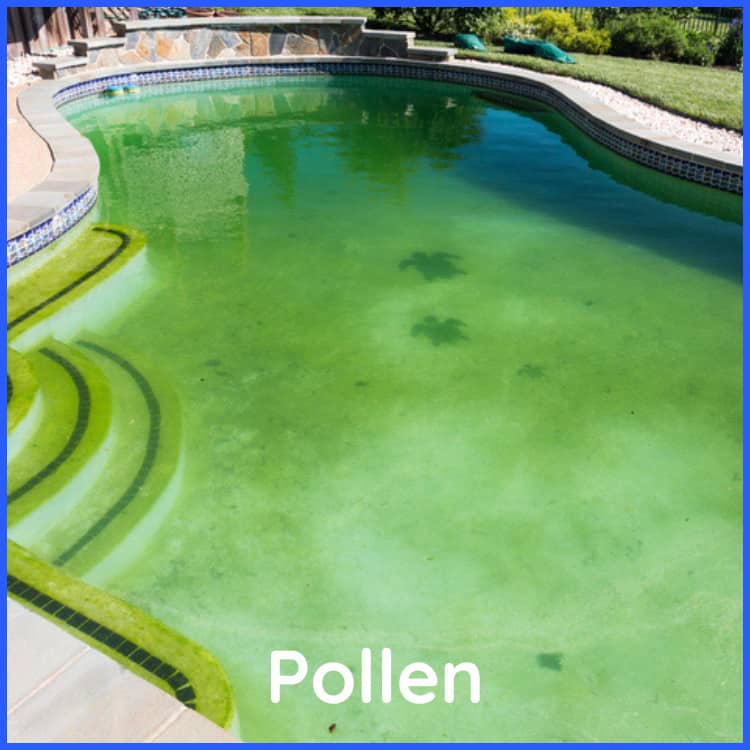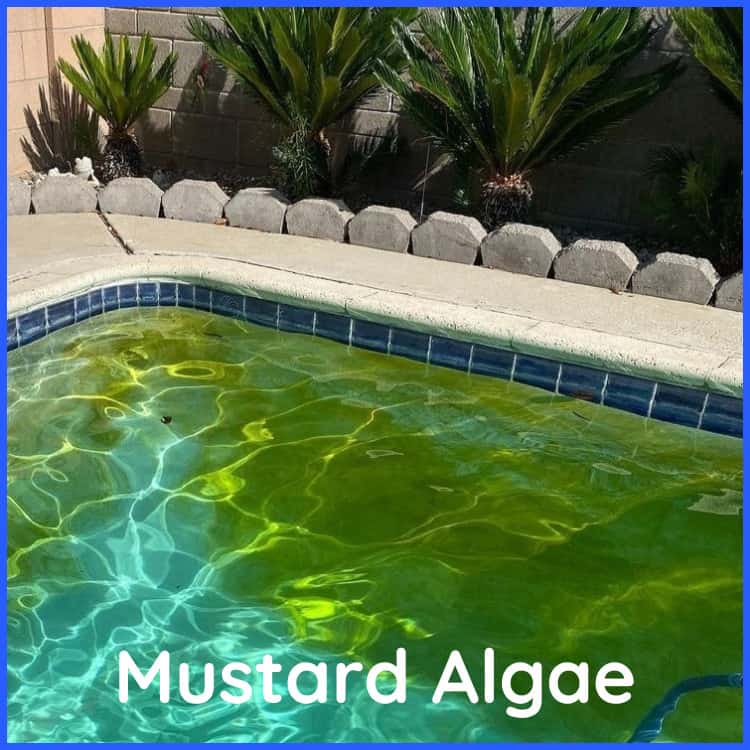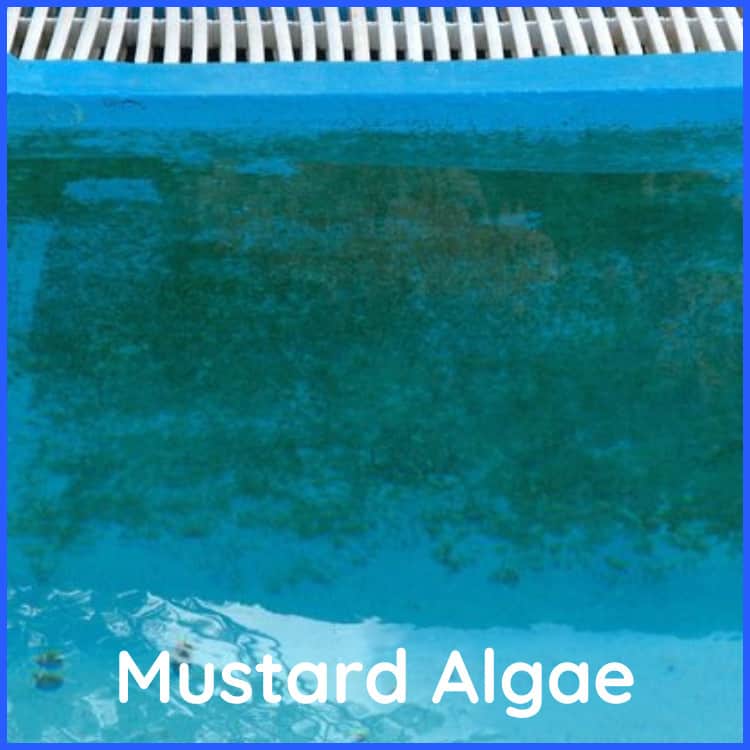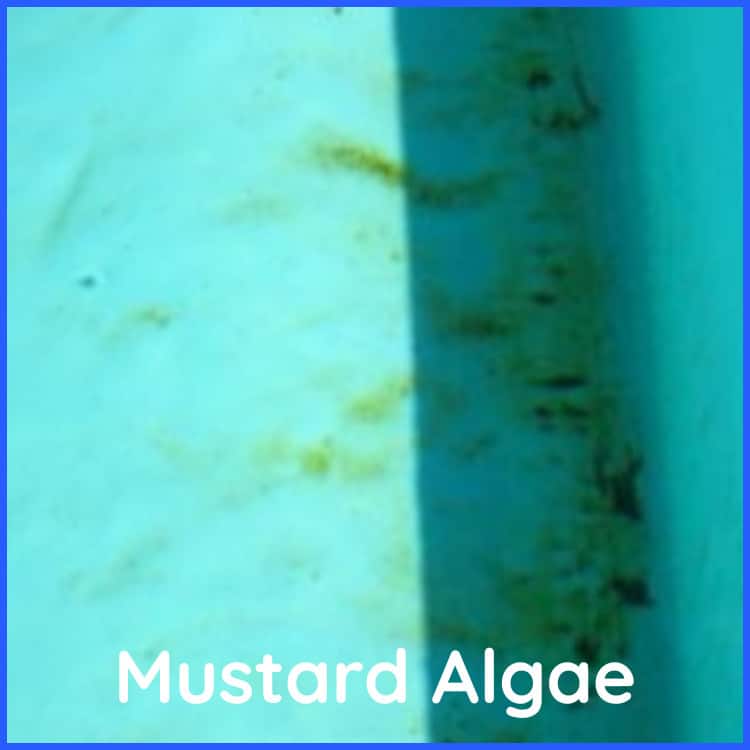Mustard Algae or Pollen? How to Know (With Pictures)
Mustard algae and pollen are often confused because they look very similar. However, unlike pollen, mustard algae will climb/scale walls, feel slimy when handled (but is often difficult to pick up as it ‘disappears’ in your fingers), congregate in shade, grows when isolated in a jar, and will drop chlorine levels overnight greater than 1ppm.
Below, I’ll go into these differences in more detail, providing pictures where I can. I’ll also offer a removal and prevention process for both MA and pollen (and will provide linked resources for further removal/prevention techniques).
Common Differences to Help Identify Between Mustard Algae and Pollen
Here are the common differences between pollen and mustard algae so you can be certain of what you’re dealing with. I’ll provide pictures where I can as well.


Chlorine Levels will Drop Overnight if There’s Mustard Algae in the Pool
One of the clearest signs you have mustard algae and not pollen is if the chlorine levels drop by more than 1ppm overnight. This is because Algae will consume chlorine as it grows.
The best way to test this is by performing an overnight chlorine loss test (OCLT). This is where you test chlorine in the water after sundown and re-test in the morning before sunrise. This will check if there is any organic matter growing in the pool.
This is because chlorine is consumed by two things: sunlight and organic contamination. By testing chlorine levels at night (when the sun is down), we can rule out sunlight as a reason for chlorine loss.
To perform an OCLT, switch off any salt water generators, tablet chlorinators, and chlorine feeders. Then, when the sun is down, run the pump for 30 minutes to mix the water and test your water for chlorine after. Make sure the level is above 3 ppm. Record this result and wait till morning.
Before sunrise, run your pump for 30 minutes and then test the water again after. If the chlorine levels stayed the same or went down less than 1ppm, there was nothing in the pool. However, if it goes down greater than 1ppm, you likely have algae in your pool, not pollen.
Is There Pollen Dust Scattered Around Your Pool?
A great way to check if you have a pollen or mustard algae problem is to actually look outside of the pool. If you have a very thin film or layer of pollen around the external areas of your pool, it’s likely you have pollen inside your pool as well, not mustard algae.
Pollen can also cling to the edge of the pool, floating around the sides. I’ve read that some people mistake this for calcium scaling. I’ll leave a picture below for an example.

Mustard Algae Can Scale/Climb Walls (Pollen Can’t)
If you notice the yellow/brown material sticking to the walls, steps, and sides of your pool, you probably have mustard algae. Pollen can’t stick or cling to vertical services – it will fall and settle at the bottom of the pool.


It is also possible to differentiate between mustard algae and pollen if the material is free floating. If it is, it’s likely pollen. However, if the chlorine in the pool is critically low, mustard algae can also float freely, but this is rare.
Mustard Algae will Feel Slimy (Pollen Feels Gritty or Squishy)
Mustard algae feels slimy when you touch it. Pollen feels gritty and often squishy. So, try picking some up and get an idea of the texture. This could tell you what you’re dealing with.
Saying this, both mustard algae and pollen are quite tough to pick up. However, mustard algae (and algae in general) will cloud up and disappear in your hand when you try and scope it up. Pollen will just move around.
Mustard Algae will Cloud and Disappear When Brushed
As mentioned briefly above, mustard algae will cloud and disappear when brushed or swirled. Pollen will tend to disperse and move to a different location.
To test, grab yourself a brush or stick your hand down to the spot which you think has algae. Sweep and swirl to see how the material reacts. If it clouds and vanishes, it’s mustard algae. If it moved around, it is pollen.
Pollen can also clump at the bottom of a pool as it gets pushed around easily by water movements.

Also, mustard algae is stubborn and likes to cling. So, if you’re scrubbing and it’s taking a while for the material to come loose, you could be dealing with mustard algae.
Mustard Algae will Grow in the Shade (Pollen Scatters Everywhere)
A classic sign you’re dealing with mustard algae is that the material is only situated in the shade. Pollen, on the other hand, can land anywhere on the surface.
Mustard algae loves the shade, so it’ll congregate in shaded areas of the pool.


If the material you’re investigating suspiciously gathers in ONLY shaded areas of the pool, you’re probably dealing with mustard algae.
Mustard Algae will Grow in an Isolated Jar
If you fancy a science experiment, you can always use the “jar test” or “bucket test”. This tests for mustard algae by seeing if the material grows or expands in an isolated environment. If it does, you’re dealing with algae.
To perform this test, grab a mason jar or bucket and scope up some of the pool water. Then, grab an eye dropper or bulb syringe, your goggles and swimwear, and swim down to the yellow/brownish patch. Use the dropper to suck up some of the material and add it to the jar/bucket of pool water you just filled.
Leave the bucket for 24 hours. If there is an obvious increase in material, then you’re probably dealing with mustard algae.
How to Get Rid of Mustard Algae
Mustard algae is a particuarly stubborn form of algae that can baffle even the most seasoned pool experts. If you’ve identified it to be algae or you just want to be sure, I’ll provide some basic steps below to remove mustard algae from your pool.
Bear in mind, mustard algae is resistant to chlorine, so you’re going to need a lot. Shock will probably work best for most of you. However, you can use liquid chlorine or bleach if you don’t want to add too many minerals and increase your pool’s hardness.
Step One: Scrub and Clean the Pool
- Grab your pool brush and get scrubbing. Make sure to get any yellowish dust off the pool floor, sides, steps, and lights. You want to be thorough because mustard algae will hide in sneaky places. Get as much of the material into a free float as possible
Step Two: Balance the Chemicals
- Now, make sure your chemicals are all balanced. This includes Ph and alkalinity. You want the Ph to be in the perfect 7.4-7.6 range and alkalinity should be between 100-150ppm. This will ensure the chlorine you’re about to add is highly effective.
Step Three: Triple Shock the Pool (Increase Chlorine to 30ppm)
- Dump lots of chlorine into the pool. You can use shock if you have it on hand. If you do, use 3 lbs for every 10,000 gallons of pool water.
- In terms of the shock you should be using, the most common is cal-hypo. However, my recommended one is a sodium-based shock as this will reduce the minerals added to your pool (increasing hardness). Trichlor is a favourite.
- Liquid chlorine or bleach is an even better option for this if you just want to add pure chlorine. If you’re using this method, you should aim to get your chlorine levels up to around 30 ppm. This is typical of the SLAM method of pool maintenance.
- Do not use chlorine pucks as this won’t increase the chlorine quickly enough. They’ll also add CYA to your water which will reduce the chlorine’s effectiveness.
Step Four: Brush Again
- Leave the chlorine in the pool for 24 hours with the pump running and continue brushing when you can. Make sure all the material is off the surfaces.
Step Five: Repeat Shocking and Brushing
- If you notice there is still algae or yellowish material in your pool after this, repeat the shocking and brushing process. This isn’t an overnight solution and often requires a few days. As I said, mustard algae is stubborn.
- Try to keep your chlorine levels high if you’re performing this over a number of days. This will make sure the algae is being attacked consistently.
- If you find the material is still there after several days of chlorine treatment and shocking, it might just be good ol’fashioned pollen.
How to Get Rid of Pollen
Pollen is actually an annoying one to get rid of because it’s so fine and can sometimes bypass a sand filter. However, there are a few ways you can remove it from your pool if you’ve confirmed it isn’t mustard algae.
Vacuum to Waste
Vacuuming the pollen is probably the quickest way to get it out of your pool. Just make sure you set the filter to waste so you make sure no pollen escapes back into your pool. Even with a filter, pollen can still wiggle its way through.
Add a Skimmer Sock
If you want to make sure your filter systems are catching the pollen effectively, you can always use a skimmer sock. This is a thin material placed over a skimmer to catch fine materials before they enter the filter.
They’re primarily used to catch pollen. You can pick them up cheaply at most pool stores.
Add DE to Your Sand Filter
If you’re using a sand filter, you could try adding some DE.
DE stands for Diatomaceous Earth, and it’s the fossilized remains of a type of hard-shelled algae. DE helps to trap and catch small particles that can slip through your sand filter.
To add DE to your filter to help catch pollen, first take note of your filter’s PSI with the pump running. Then, mix 1/4 cup of DE in a bucket with water and pour it into your skimmers. Be sure to remove the skimmer sock beforehand. Wait for 2 minutes. After the time is up, take note of the PSI again.
To finish the process, repeat the last three steps (adding DE, waiting, then checking PSI) until the PSI has increased by 1.
How to Prevent Mustard Algae
Once you’ve got rid of mustard algae, it’s important to keep on top of it and make sure it never comes back. Mustard algae is a fast grower and will be back in your pool without proper maintenance.
I’ll provide a few ways below on how you can prevent mustard algae from returning for good:
- Keep Chlorine Levels High: It’s important to keep your chlorine levels high to prevent any further growth. This is especially important if you’re using the SLAM method. If you’re not, regular pool shocking (once a week) will help to keep any further algae blooms from happening.
- Keep Chemicals Perfectly Balanced: Make sure the water chemistry is balanced (Ph and Alkalinity). This will make sure the chlorine you’re adding is having the strongest effect it can.
- Wipe Toys, Accessories, and Clean Swimwear Often: Mustard algae can get into your pool from outside sources like lakes and rivers. Make sure you’re washing swimwear regularly and wiping down toys and equipment after use. If you have good chemistry algae won’t grow but this is just an extra level of precaution.
- Keep the Pump and Filter Running Correctly: Ensure your pump and filter is running for at least 8 hours a day. The ideal is 8-12. This will help chemicals evenly distribute across the pool.
- Try Phosphate Remover: If you live in an area with lots of trees, greenery, etc. it could be a good idea to add phosphate remover to your pool. This will kill any food source for the mustard algae, preventing it from returning.
How to Prevent Pollen
If you’ve gotten rid of the pollen and want to prevent it from returning, there is a simple thing you can do to stop it from getting in your pool. Get a pool cover!
This is a simple prevention tip that most pool owners can implement and from my learnings, it does the job just fine.
If you find the cover is very dusty and full of pollen when you go to open your pool, turn your pump on and spray the cover with a garden hose. Aim to push as much debris and pollen into the skimmers as possible.
Other than that, you sometimes just have to suck it up. Pollen is not a huge issue for most pool owners – it’s more of an annoyance. With things like skimmer socks or DE filters, there are alternative ways to prevent it as mentioned above.
